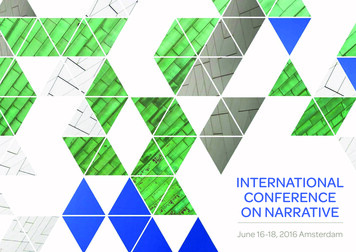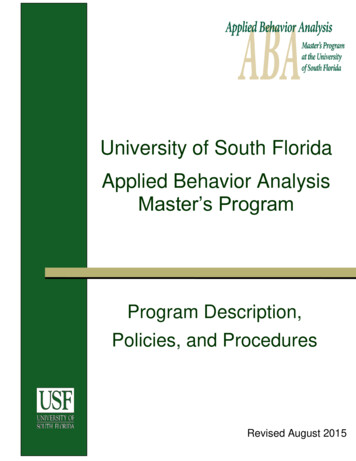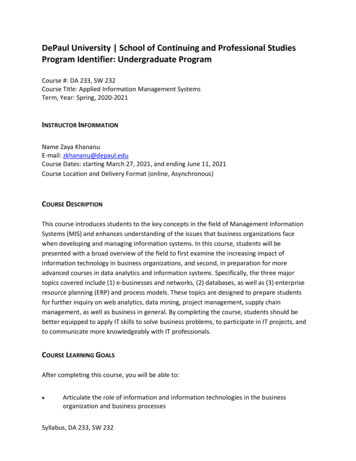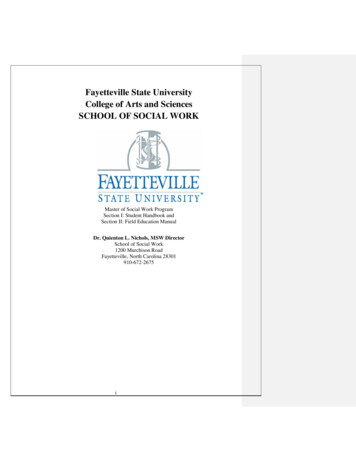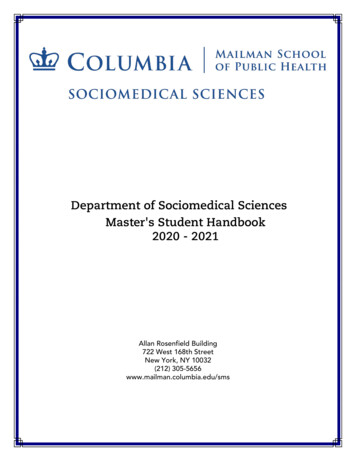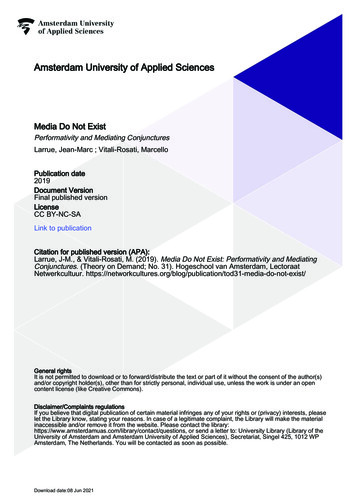
Transcription
Amsterdam University of Applied SciencesMedia Do Not ExistPerformativity and Mediating ConjuncturesLarrue, Jean-Marc ; Vitali-Rosati, MarcelloPublication date2019Document VersionFinal published versionLicenseCC BY-NC-SALink to publicationCitation for published version (APA):Larrue, J-M., & Vitali-Rosati, M. (2019). Media Do Not Exist: Performativity and MediatingConjunctures. (Theory on Demand; No. 31). Hogeschool van Amsterdam, LectoraatNetwerkcultuur. -media-do-not-exist/General rightsIt is not permitted to download or to forward/distribute the text or part of it without the consent of the author(s)and/or copyright holder(s), other than for strictly personal, individual use, unless the work is under an opencontent license (like Creative Commons).Disclaimer/Complaints regulationsIf you believe that digital publication of certain material infringes any of your rights or (privacy) interests, pleaselet the Library know, stating your reasons. In case of a legitimate complaint, the Library will make the materialinaccessible and/or remove it from the website. Please contact the ct/questions, or send a letter to: University Library (Library of theUniversity of Amsterdam and Amsterdam University of Applied Sciences), Secretariat, Singel 425, 1012 WPAmsterdam, The Netherlands. You will be contacted as soon as possible.Download date:08 Jun 2021
MEDIADO NOTEXISTPERFORMATIVITYAND MEDIATINGCONJUNCTURES
2THEORY ON DEMANDTheory on Demand #31Media Do Not Exist: Performativity and Mediating ConjuncturesAuthors: Jean-Marc Larrue, Marcello Vitali-RosatiThis book was translated from an original French manuscript by John Detre and Beth KearneyCover design: Katja van StiphoutDesign and EPUB development: Valeria PugliesePublished by the Institute of Network Cultures, Amsterdam, 2019ISBN: 978-94-92302-39-7ISBN epub: 978-94-92302-38-0ContactInstitute of Network CulturesPhone: 3120 5951865Email: info@networkcultures.orgWeb: http://www.networkcultures.orgThis publication is licensed under the Creative Commons Attribution-NonCommercial-NoDerrivatives 4.0 International (CC BY-NC-SA 4.0)This publication is made available through various print on demand services and freely downloadable from http://www.networkcultures.org/publications
3MEDIA DO NOT EXISTCONTENTSFROM THE BIRTH OF INTERMEDIAL THINKINGTO THE CONCEPT OF REMEDIATION:THE MEDIATIC PHASE OF INTERMEDIALITY6IntroductionHistorical OverviewRemediation, Central Concept in Intermediality’s Mediatic PeriodPostmediatic Intermediality: Remediation and BeyondESSENCE AND PERFORMATIVITY31IntroductionEssence and Flux: The Irreducibility of MovementDiscrete, Continuous, DigitalMedia and ActionSupportInterfaceApparatusPerformativity in IntermedialityPerformativity as a Component of ActionDrama and PerformanceThe Temporal Structure of ActionThe UndecidedMediation as PerformativityMEDIATING CONJUNCTURES52Between Multiplicity and IdentificationThe Dimensions of Mediating ConjuncturesPerformativity and MetaontologyMEDIATING CONJUNCTURES AND MEDIATION65Historical Perspectives on Mediation: Individuation, Naturalization and SociomedialitiesPostmediatic PerspectivesThe Formless: Beyond LanguageRadical Mediation: Updating the Remediation ModelMediation as ExcommunicationConclusion
4THE DIGITAL AND THEATERAS MEDIATING CONJUNCTURESTHEORY ON DEMAND77The Digital as Mediating ConjuncturesTheater as Mediating ConjuncturesBIBLIOGRAPHY107
MEDIA DO NOT EXIST5ACKNOWLEDGMENTSThis book is the result of research conducted within the Canada Research Chair on DigitalTextualities (http://digitaltextualities.ca), financed by the Social Sciences and HumanitiesResearch Council of Canada and by Le Fonds de recherche du Québec –Société et culture.Nobody thinks alone: the ideas presented here stem from many years of discussion and collaboration. In many ways, we are not the sole authors. Special thanks go to Peppe Cavallari,Filip Dukanic, Lars Elleström, Erwan Geffroy, Chiel Kattenbelt, Éric Méchoulan, ServanneMonjour, Élisabeth Routhier, Nicolas Sauret, Michael Eberle Sinatra for their assistance, theirsuggestions, their ideas, their time and their friendship.Thanks are also in order to other research bodies who supported our writing of this essay:CRILCQ (Interuniversity Research Centre on Québec Literature and Culture), CRIHN (Interuniversity Research Centre on Digital Humanities) and our colleagues from the Centre ofIntermedial Research in Arts, Literatures and technologies (CRI/CRIalt) and the InternationalSociety for Intermedial Studies (ISIS).This book has been translated from an original French manuscript by John Detre and BethKearney. It was proofread by Beth Kearney. We are very grateful to them for their respectful,attentive and brilliant work which has made these pages possible.
6THEORY ON DEMANDFROM THE BIRTH OF INTERMEDIAL THINKING TOTHE CONCEPT OF REMEDIATION: THE MEDIATICPHASE OF INTERMEDIALITYIntroductionHenry Jenkins, the keynote speaker at the founding conference of the International Societyfor Intermedial Studies (ISIS), held in Cluj, Romania in October 2013, opened his remarksby expressing surprise at the turnout. It wasn't false modesty; he was genuinely baffled thatthe 250 intermedialists in attendance, few of whom were specialists in media or communications, should be interested in his work and that of his colleagues at MIT's Comparative MediaStudies Program. The intermedialists hailed from other disciplines in the social sciences andhumanities: literature, art history, cinema, music, video, theater, linguistics, history, philosophy, anthropology. Two days later, the author of Convergence Culture recovered from hissurprise. At the end of the plenary session that closed the first ISIS conference, he remarked,'I assume that what I have been doing for years is intermediality or has something to do withintermediality'. To the attendees, this was self-evident.This telling anecdote speaks to a readily observable fact: intermedial research is more common than one might think, but it often appears under other names, and is dictated by disciplinary convention, institutional constraints and editorial policies that occur in the parts ofthe world where it is conducted.Born in the wake of what Milad Doueihi calls the great digital conversion1 and what is commonly referred to as the digital revolution, intermedial studies are barely 30 years old. That'snot much, considering the dispersal and often isolation of the first intermedial researchers,an isolation that was aggravated precisely by the profusion of labels used to describe theirsubject matter. It took almost 10 years – from the mid-1980s to the mid-1990s – beforebridges were built between some of the research groups and the first international researchnetwork began to take shape. And it was another 20 years before an international scientificassociation devoted to intermedial studies was formed with the ISIS founding conference inCluj, October 24-26, 2013.While the scattered emergence of intermedial thinking impeded the discipline's growth, it alsoattests to the supranational and supradisciplinary scope of the intermedial approach, andthe ubiquity of the gaps it addresses. Those gaps are not confined to the lightning-fast digitalinvasion, which has radically transformed our lives since the end of the 20th century, butexisted during the pre-digital age, as well. As Espen J. Aarseth observed in one of the foundational texts of game studies,2 information technology did not make the cybertext possible;cybertexts existed before computers and cybertextual thinking dates back several millennia.12Milad Doueihi, Digital Cultures, Cambridge, Mass.: Harvard University Press, 2011.Espen J. Aarseth, Cybertext: Perspectives on Ergodic Literature, Baltimore, Md: Johns HopkinsUniversity Press, 1997.
MEDIA DO NOT EXIST7In support of this assertion, Aarseth shows how the famous Chinese book of changes, theI Ching, which dates back to the Zhou dynasty (1027-256 BC), was already a cybertext.The intermedial approach likewise investigates processes that extend into the distant past.Researchers such as Peter Boenisch3 argue that intermedial processes have existed sincethe invention of the alphabet, and interartistic theoreticians4 regard the complex, ceaselessrelationships between artistic disciplines since antiquity as compelling models of intermedialdynamics. One of the first propositions advanced by the intermedialists was that the arts aremedia, indeed the oldest media, and that intermedial phenomena date back tens of millennia.The term intermediality first gained currency in Germany, Belgium, the Netherlands andCanada. Germany may be considered the birthplace of intermedial thinking, while Canadawas the site of the first scientific research center devoted to it, the Centre de recherchesintermediales/Centre for Intermedial Research (CRI) at the Université de Montréal, foundedin 1997. However, for the reasons we have mentioned, the term 'intermediality' remainedconfined to a small circle of researchers, even as studies in the field, such as those conductedby Henry Jenkins at MIT, proliferated. In other words, intermedial reflection developed steadilyand was constantly enriched, unbeknownst to the researchers themselves. A few examples:in 2000, the American researchers Jay David Bolter and Robert Grusin published what wouldbe considered a groundbreaking work in intermedial studies: Remediation. UnderstandingNew Media.5 The concept of remediation they develop is at the heart of intermedial dynamics.But nowhere in their 295-page tome do the words 'intermedial' or 'intermediality' appear.The same is true of other seminal texts in the evolution of intermedial thinking in the USsince the late 1980s. In When Old Technologies Were New,6 which may be considered oneof the foundational texts of American intermedial studies, Carolyn Marvin discusses how, asthe use of electricity became widespread in the 19th century, electrical media emerged bycannibalizing each other, transforming interpersonal relationships and social behaviour in theprocess. Her book came out at the same time as the first essays by German intermedialistson related themes, but they do not appear to have been aware of each other.In 1999, as digital technologies were invading the theatrical stage, Philip Auslander's iconoclastic book Liveness: Performance in a Mediatized Culture7 took aim at the deep-rootedidea that the direct physical co-presence (in the same place, in the flesh) of senders and34567Peter Boenish, 'Mediation Unfinished: Choreographing Intermediality in Contemporary DancePerformance', in Intermediality in Theatre and Performance, ed. by Freda Chapple and Chiel Kattenbelt,Amsterdam; New York: Rodopi, 2006, pp. 151-66.Claus Clüver, 'Intermediality and Interarts Studies', in Changing Borders: Contemporary Positionsin Intermediality, ed. by Jens Arvidson, Lund: Intermedia Studies Press, 2007, pp. 19-37; WaterMoser, 'L'interartialité: pour une archéologie de l'intermédialité', in Intermedialité et socialité: histoire etgéographie d'un concept, ed. by Marion Froger and Jürgen E and Müller, Münster: Nodus, 2007, pp.69-92.J. David Bolter and Richard A Grusin, Remediation: Understanding New Media, Cambridge, Mass.: MITPress, 2000. The title echoes the resounding essay published by Marshall McLuhan, UnderstandingMedia, New York: Signet, 1966.Carolyn Marvin, When Old Technologies Were New: Thinking About Electric Communication in the LateNineteenth Century, Nachdr., Ill, 1990.Philip Auslander, Liveness: Performance in a Mediatized Culture, London; New York: Routledge, 2011.
8THEORY ON DEMANDreceivers in a venue such as the theater and technological mediatization were irreconcilable.Auslander argued that those distinctions born of the operation of electrical media in the late19th century cannot withstand the reality test: liveness may be mediatized and still be live.In 2003, Jonathan Sterne published another key intermedial work: not only did The AudiblePast 8 revolutionize sound studies, but it also expanded intermedial analysis to the world ofsound, uncovering the full complexity of mediation processes and underlining the hazardsof transposing concepts from visual studies to sound studies. In Always Already New: Media,History, and the Data of Culture,9 Lisa Gitelman questions whether what were then referredto, by researchers and in society in general, as 'new media' in the industry really were new.Adapting and developing Derrida's well-known phrase, she contends that all media werealways already new. Gitelman's analysis was grounded in a synthetic definition of media towhich no intermedialist, in the US or elsewhere, would have objected at the time. She alsoclarifies and enriches, without naming it, the central concept of remediation, while AlexanderR. Galloway questions it in The Interface Effect10 and Craig Dworkin investigates modes ofmediation in No Medium.11 In the same year as the publication of Galloway's The InterfaceEffect, Erkki Huhtamo and Jussi Paikka's What Is Media Archaeology?12 marked the arrivalof media archaeology as a recognized scientific discipline. Archeology is one of the mainbranches of intermediality and the remediation model is one of its cornerstones.Other important texts in narratology and studies of adaptation, reception, electroacoustics, literature and the early cinema published during this period also adopted an intermedial perspective, but none of those books and articles that so shaped the development of thinking aboutintermediality, not only in the US but around the world, contained the word 'intermediality'.The same observation can be made about intermedial studies in the French-speaking world,with the exception of research activities in Canada around the Centre de recherche sur l'intermédialité at the Université de Montréal. Works by Philippe Marion on linkages betweenmedia,13 by François Odin on the 'births' of cinema, by Jean-Luc Déotte on the concept ofapparatus14 and by the Toulouse group15 on the concept of device explore issues in intermediality without calling them by this name. Texts by Jacques Rancière on the medium and,89101112131415Jonathan Sterne, The Audible Past: Cultural Origins of Sound Reproduction, Durham [N.C.: Dukeuniversity press, 2003.Lisa Gitelman, Always Already New: Media, History, and the Data of Culture, The MIT Press, 2008.Alexander R Galloway, The Interface Effect, Cambridge, UK; Malden, MA: Polity, 2012.Craig Dworkin, No Medium, 1st MIT Press paperback edition, Cambridge, Mass London: MIT Press,2015.What Is Media Archeology., ed. by Erkki Huhtamo and Jussi Parikka, Cambridge: Polity Press, 2015.Philippe Marion, L'année des médias 1996, 1997 83077 [accessed 16 February 2019].Jean-Louis Déotte, Appareils et formes de la sensibilité, L'Harmattan, 2005.Philippe Ortel, 'Note sur une esthétique de la vue: Photographie et littérature', 2002 .3406/roman.2002.1164; Arnaud Rykner, Le tableau vivant et lascène du corps : vision, pulsion, dispositif, Hyper Article en Ligne – Sciences de l'Homme et de laSociété, 2013 https://isidore.science/document/10670/1.0jcfgt [accessed 16 February 2019].
MEDIA DO NOT EXIST9more recently, on the (emancipated) spectator,16 by Daniel Sibony on the in-between17 andby Deleuze on cinema (particularly the crystal image)18 made such important contributions tointermedial studies that they would certainly warrant inclusion on any list of essential readingsin intermediality, but none were, at the time, published under the banner of 'intermediality'.This first observation leads us to a second. To this day, in the minds of many observers ofthe social sciences and humanities in general, and the field of arts and media in particular,intermediality boils down to the junction of artistic practices, most often in the form of atechnology transfer from one practice to another: using projected images in theatrical productions, turning movies into video games, using photographs in literary texts, and so forth.Certainly, these are all examples of intermedial dynamics, but intermediality is much morethan this, as we will show.Historical OverviewFor nearly 20 years, up to the mid 2000s, intermedial research was dominated by a fairlytraditional conception of media, which we shall discuss in a later chapter. Intermedial studiessprang from a paradox that digital technology had lain bare: not only do media constantlyinteract, but they are themselves the products of such interactions. This singular dynamicbecame the focus of the intermedialists, who sought to understand how, by what means andto what end it was produced. But over the past 10 years or so, the picture has grown murkieras the very concept of media has been challenged; indeed, whether such a thing exists orhas ever existed is questionable. The relatively brief history of intermediality can thereforebe divided into two periods: the mediatic period and the postmediatic period. The first wasfounded on a relatively traditional conception of media inherited from Marshall McLuhan andcommunication theory. The second wrestled itself free from that frame. The transition fromone to the other illustrates intermediality's arduous but successful struggle for emancipationfrom the poststructuralist mindset from which it emerged.As we understand it, intermediality refers at once to a field of study, a dynamic and anapproach. As a field of study, it deals with complex, rich, polymorphous, multidirectional relationsamong 'mediating conjunctures'.19 As a dynamic, intermediality is what makes the production and evolution of such 'mediating conjunctures' possible; it also leaves in its wake media residues, scraps of uncom-16171819Jacques Rancière, Le spectateur émancipé, La Fabrique éditions, 2008.Daniel Sibony, Entre-deux: l'origine en partage, Paris: Editions du Seuil, 2003.Gilles Deleuze, Cinéma, Paris: Éditions de Minuit, 1983.For reasons to be explained later, we prefer the expression 'mediating conjuncture' to 'media'. Duringintermediality's 'mediatic period', media was the preferred term cf Éric Méchoulan, 'Intermédialités: letemps des illusions perdues', Intermédialités: Histoire et théorie des arts, des lettres et des techniques /Intermediality: History and Theory of the Arts, Literature and Technologies, 1, 2003, 9-27 https://doi.org/https://doi.org/10.7202/1005442ar.
10THEORY ON DEMANDpleted mediation processes, the remnants of 'mediating conjunctures' that have passedinto history. Consequently, we call for an original approach that can yield a better understanding ofthis field and this dynamic.For the first intermedialists, it was vitally important to grasp media (to use the terminologyof the day) as part of a larger dynamic from which they drew their power. From the outset,therefore, the producers and users of media played a central role in intermedial reflection,to the same extent as the materiality of mediation processes. The early intermedialists, particularly those interested in electrical media, brought new and sustained attention to bearon the social environment from which media emerge and on which they act. This interestin sociality is worth noting because the first intermedialists were often wrongly accused oftechnocentrism, when in fact they held that media practices could not be dissociated fromthe individuals who were their agents. The socialities associated with media or created bymedia – from the first telephones to contemporary social networks – are not comparable totraditional social classes nor to stable communities; hence the neologism 'sociomedialities'is used to refer to these socialities that are specific to media and shaped by the processes ofnaturalization and universalization that traverse media.20Etymologically, the term intermediality de
R. Galloway questions it in The Interface Effect10 and Craig Dworkin investigates modes of mediation in No Medium.11 media, THEORY ON DEMAND. THEORY ON DEMA
